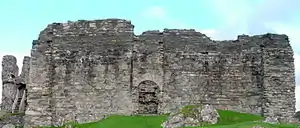Castle Sween
Castle Sween, also known as Caisteal Suibhne,[1] and Caistéal Suibhne,[2] is located on the eastern shore of Loch Sween, in Knapdale,[3] south of the forestry village of Achnamara on the west coast of Argyll, Scotland. Castle Sween is thought to be one of the earliest stone castles built in Scotland, having been built in the late 11th century.[4][3] The castle's towers were later additions to wooden structures which have since vanished.[3]
| Castle Sween | |
|---|---|
| Achnamara, Loch Sween, Knapdale, Argyll, Scotland | |
 | |
 Castle Sween | |
| Coordinates | 55.9479°N 5.6654°W |
| Type | Castle |
| Site information | |
| Owner | Historic Scotland |
| Site history | |
| Built | 12th century |
| Built by | Suibhne |
History
Castle Sween is the oldest stone castle in Scotland, built in the late 11th century by Suibhne, son of Hugh Anrahan, brother of the king of Ulster and High King of Ireland, from whom it takes its name Suibhne.[5]
As late as the thirteenth century, the MacSweens possessed the surrounding lands of Knapdale. However, by the second half of the century, these territories passed into the hands of the Stewart/Menteith family.[5]
In 1310, Edward II, King of England, granted John MacSween, and his brothers, the MacSweens' ancestral lands of Knapdale, provided that they oust John Menteith. It is possible that MacSween, and his claim to his family's lost Scottish homeland, may be the subject of the Gaelic poem Dál chabhlaigh ar Chaistéal Suibhne. If so, this poem may well refer to an expedition by MacSween to retake Castle Sween in about 1310.[5]
In 1323, after the death of John Menteith, the Lordship of Arran and Knapdale passed to his son and grandson. In 1376, half of Knapdale, which included the castle, passed into the possession of John MacDonald I, Lord of the Isles, by a grant from his father-in-law, Robert II, King of Scotland.[5]
During the MacDonalds' century and a half of holding the castle, the castellans were first MacNeils and later MacMillans.[6]
In 1490 Castle Sween was granted to Colin Campbell, 1st Earl of Argyll, by James IV, King of Scotland.[6]
In 1647, during the Wars of the Three Kingdoms, Castle Sween was attacked and burnt by Alasdair MacColla and his Irish Confederate followers.[6]
In 1933 the castle was put in the care of the Historic Building and Monuments Directorate (HBMD).[7] Currently Castle Sween is under the protection of Historic Scotland.[7]
Citations
- Raven (2005) p. 59.
- Argyll: An Inventory of the Monuments (1992) p. 258 § 119.
- http://www.historic-scotland.gov.uk/properties_sites_detail.htm?propertyID=PL_061 Retrieved on June 19, 2007
- MacPhee, Somerled, Hammer of the Norse, 2004, p. 67
- Ewart; Triscott; Holmes et al. (1996) p. 518; MacPhee, Kathleen, Somerled, Hammer of the Norse (2004), p. 67.
- http://www.ccsna.org/castles/sween.html Archived 2007-07-12 at the Wayback Machine Retrieved on June 19, 2007
- http://www.darkisle.com/s/sween/sween.html Retrieved on June 19, 2007
References
- Argyll: An Inventory of the Monuments. Vol. 7, Mid Argyll & Cowal. The Royal Commission on the Ancient and Historical Monuments of Scotland. 1992. ISBN 0 11 494094 0 – via ScotlandsPlaces.
- Ewart, G; Triscott, J; Holmes, NM McQ; Caldwell, D; Stewart, H; McCormick, F; Holden, T; Mills, C (1996). "Archaeological Excavations at Castle Sween, Knapdale, Argyll & Bute, 1989–90" (PDF). Proceedings of the Society of Antiquaries of Scotland. 126: 517–557. eISSN 2056-743X. ISSN 0081-1564 – via Archaeology Data Service.
- Raven, JA (2005). Medieval Landscapes and Lordship in South Uist (PhD thesis). Vol. 1. University of Glasgow – via Glasgow Theses Service.
External links
| Wikimedia Commons has media related to Castle Sween. |